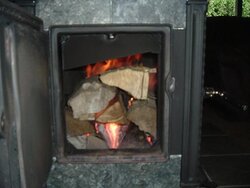Ok
I have had my stove for a couple of months and I still have questions. I cant seem to get my stove top temp over 400. Where do you normally leave the air supply lever during a normal after work before bed time fire??? I was pushing it back about 1/2 to 3/4 but sometimes the flames would get so small It would just glow. Then I add a little air and it takes off. I dont know what else to try to get the temp up. Im using real seasoned hard woods. The other question Im having is the overnight. I go to bed at 12 and when I wake up at 6 I have a warm stove and no embers. How can I get longer burn times over night. I pack it full with wood Burn it full open for about 15 min then cut the air supply to about 10 % open. But when I wake up there is nothing but Ashes. The stove is still warm to the touch, but I need to build a fire from scratch to restart it.
Thanks
Andy
I have had my stove for a couple of months and I still have questions. I cant seem to get my stove top temp over 400. Where do you normally leave the air supply lever during a normal after work before bed time fire??? I was pushing it back about 1/2 to 3/4 but sometimes the flames would get so small It would just glow. Then I add a little air and it takes off. I dont know what else to try to get the temp up. Im using real seasoned hard woods. The other question Im having is the overnight. I go to bed at 12 and when I wake up at 6 I have a warm stove and no embers. How can I get longer burn times over night. I pack it full with wood Burn it full open for about 15 min then cut the air supply to about 10 % open. But when I wake up there is nothing but Ashes. The stove is still warm to the touch, but I need to build a fire from scratch to restart it.
Thanks
Andy


